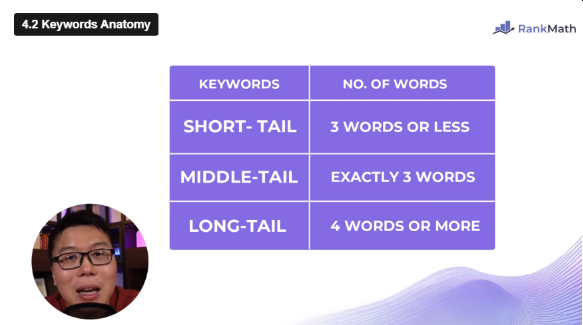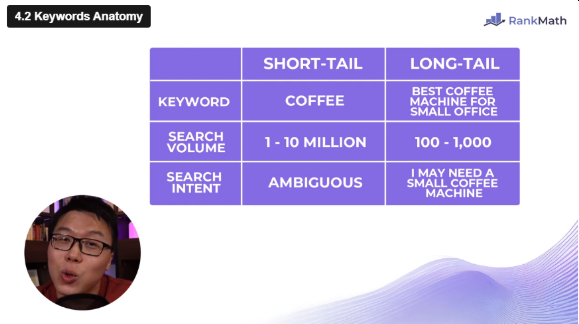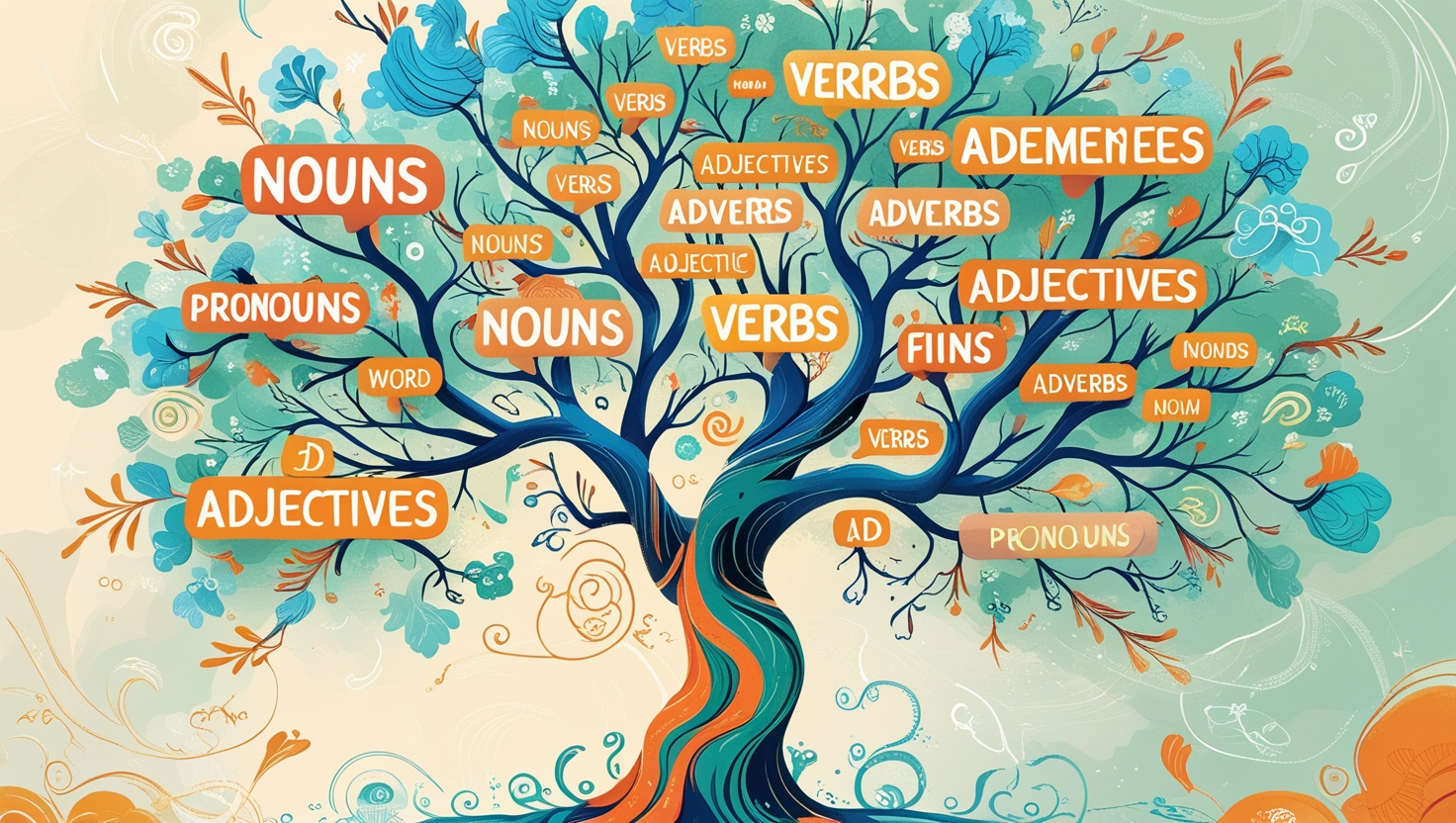Why do you need to know about defining the types of keywords? It is to do with the way people use keywords and how it can reveal the elusive search intent.
Table of Contents
ToggleDefining the Types of Keywords
We are all familiar with the concept of a keyword, essentially any term or phrase you put into the search engines. But, did you know, there are different classifications for these keywords?
There are short-tail and there are long-tail keywords. In this article, we shall learn about defining the types of keywords.
Keywords Anatomy
Short-tail keywords are terms of 3 words or less, but some would call terms of 3 words as middle-tail keywords. In contrast, long-tail keywords have 4 or more words.

Though this way of classification may appear basic, there’s a meaningful reason for it. How people use these keywords can reveal their intention. For example, the term “coffee” is searched 1M to 10M times every month.But, its broad nature makes it hard to pinpoint the searcher’s exact need.
Does the searcher want to learn more about coffee, do they want to learn how to brew coffee? What exactly does the person searching for coffee want. There’s no clear intention. However “cold brew soffee recipes”. a long-tail keyword, might have fewer searches but it indicates a clear intent.
So, short-tail keywords are broader and less specific in nature. Hence, the searcher’s intent is ambiguous. While long-tail keywords are more detailed and tend to reveal a clear intention behind a search.
But, you would say short-tail keywords get more traffic, isn’t it more logical to target them?
Let’s check it out. This is the search-demand curve. The Y-Axis represents the number of monthly searches and the X-Axis represents the variety of keywords.

At the very beginning of this curve, you have short-tail keywords, they are broad generic terms like “shoes”, “laptop” and they have incredibly high search volumes but, here’s the catch. They are also highly competitive. Everyone wants a piece of that pie.
As we move to the right of the curve, we start to see a shift. The search volume decreases but the variety of keywords increases. These are our long-tail keywords. Like “Red leather shoes for hiking” or “Laptop suitable for graphic design”. They are specific and targeted.
Now you might be thinking: “But Jack, if your search volume is so low, why should I care?”.
Here’s the magic of long-tail keywords. While each keyword might have a lower serarch volume, collectively they account for most online searches.
Imagine, 70% of all queries online , are long-tail keywords. And the best part, they are often less competitive and more targeted. Meaning that the person searching for something is likely to convert or take action.
When optimizing a website for search engines, defining the types of keywords—such as informational, navigational, and transactional—is crucial for effective SEO strategy.
A Business Perspective
Let’s look at it from a business perspective. Clear intent is key. Would you rather attract a massive crowd where only a few are genuinely interested in what you offer? Or a smaller dedicated group that’s actively seeking your product or service?
The answer’s pretty clear, right.

I’ll give you another scenario. You are a business targeting all the short-tail keywords because you need the high search volume and you wouldn’t mind the lower conversion rate. Bear in mind that the short-tail keywords are much more competitive than the long-tail keywords.
Which means you are competing with super-big sites. If you are targeting keywords like “books”. You’re competing with Amazon! Or if you are targeting the keyword “shoes”, you are competing with brands like Nike, Adidas, etc.
Which means if you fail in competing with these big sites and big brands, you don’t get any search traffic and probably won’t get any sales. On the other hand, with long-tail keywords, it’s easier to rank on search engines and give you more exposure.

The real gold lies in the long tail keywords, by targeting these specific queries, you’re positioning yourself to attract a more engaged audience and, over time, these can lead to higher conversions and more business growth.
The process of defining the types of keywords is essential for creating a well-structured content strategy that targets the right audience.

“coffee” is a short-tail keyword and “best coffee machine for a small office” a long-tail keyword. The keyword “coffee” is searched one to ten million times every month. while the “best coffee machine for small office” is searched a hundred or a thousand times every month. As we know, the search intent for the keyword “coffee” is ambiguous but. what do you think is the search intent for “best coffee machine for small office”. It simply means that people are looking for the best coffee machine that can nicely fit in a small office. It’s that simple.
And, if you create content that serves the search intent. Will it lead to a sale? Maybe!
Google tends to rank sites with a specific angle or specific niche higher than those that cover many topics. But, of course, the quality of the content still matters.
Now, I want to bring in another term which is a middle-tail keyword. Instead of “best coffee machine for small office” middle-tail keywords are something like “best coffee machine”. It has three words and should be classified as a short-tail but you get a sense of what the search intent is. That’s what middle-tail is about. They have higher search volume than long-tail keywords but the search intent is not as specific but it has lower search volume.

Conclusion
Middle-tail keywords are usually more competitive, so you may need a more complex strategy.
Defining the types of keywords helps in optimising content for search engines and improving overall digital marketing strategies.
Furthermore, understanding the thinking behind defining the types of keywords can go a long way to identifying the true search intent of a sercher’s actions.
Creating a Keyword Research Spreadsheet allows marketers to organize, analyse, and prioritize target keywords for better SEO and content strategy.




